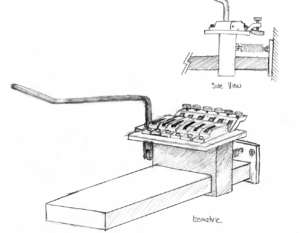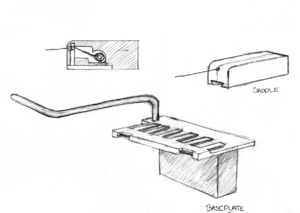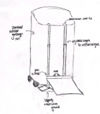Guitar bridge redesign
From DDL Wiki
Contents |
Executive Summary
Mike
Research
Description of Research
Mike
Stakeholders
Mike
Results of Research
Mike
Conclusions
Mike
Design Ideas
Linear Bridge
Jeremy
Digital Bridge
Jeremy
Cartridge Bridge
Jeremy
"Raccoon Trap" Saddles
Jeremy
Comparison of Designs
Conclusion
Jeremy
Comparison to the State of the Art
Benchmark of Performance and Function
The two bridge designs investigated, the Floyd Rose and the Fender, both are designed to answer certain questions regarding the performance of the musical instruments. The original Fender tremolo bridge was designed as a variant of a standard electric guitar bridge at the time. The Floyd Rose was designed specifically to address a problem with the Fender and earlier tremolo designs, the problem of keeping tune. However, the Floyd Rose was an imperfect solution, and also added a lot of complexity to the bridge design.
The designs we are proposing are trying to address two key issues that have been problems with tremolo bridges: keeping tune, and changing strings.
The Floyd Rose bridge was designed entirely with tuning in mind, and tuning has been the key issue for tremolo bridges since they began to enjoy wide popularity. The Fender bridge, as Floyd Rose realized, is not well suited to keeping tune, as the pivoting action the bridge uses puts tension on the strings and can distort them. Floyd Rose's bridge uses a similar action, but uses a double-locking bridge to limit the degree to which the string can go out of tune. A linear bridge design would use an entirely different dynamic process to change the string length, pulling the strings horizontally instead of using a pivot in the bridge. This will hopefully improve the guitar's ability to keep tune. Additionally, the design, though more complex than a Fender bridge, could be created with the same simple basic design as the Fender, with the additional parts being larger and easier to manufacture than the tiny saddle pivots and clamp blocks of the Floyd Rose. The electronic tremolo would be a way to create a tremolo effect without altering the strings at all, and therefore keeping the tune of the guitar easily. The other design ideas, the raccoon-trap saddles and the cartridge bridge would not directly affect the action of the bridge, and therefore wouldn't necessarily affect the tuning of a guitar, either negatively or positively.
Changing the strings on a guitar equipped with a tremolo bridge is difficult, because a tremolo requires the strings to be mounted inside the body of a guitar, which is more difficult than other string mounting methods. Both the Fender and the Floyd Rose have these issues, as both use essentially the same string mounting method.
A linear bridge design could potentially allow for easier string changes, as the springs that typically provide tension would be mounted to the bridge, meaning that it may not be necessary to use a through-body mount for the strings. The electronic tremolo would make string changing easier by obviating the need for a tremolo bridge, and therefore allowing a guitar to use a simple Fender bridge without a tremolo, which uses a simpler string mounting method. The raccoon trap string design would make the string changing process for a through-body bridge much easier. The design could make it unnecessary for the strings to be passed through the sustain block and up through the bridge, a difficult process, instead having the strings be clipped into the sustain block very simply. The cartridge bridge design would make string changing very easy, it only being necessary to clip in a cartridge, rather than passing a string through a series of small holes.
Benchmark of Stakeholder Needs
The needs of the consumer are generally in line with the performance of the guitar. One other important consideration is ease of installation. Installing a new bridge on a guitar is not a difficult process, and is fairly standardized. If the guitar has a tremolo bridge, it would have a through-bridge construction, where the strings are mounted through the bridge into a sustain block, which is mounted to the body of the guitar. Of the new bridge designs being investigated, the only one which would require a major change to a preexisting guitar would be the linear bridge, which would use an entirely different internal setup with regards to the tensioning springs and the sustain block. It is also important to note that an electronic tremolo would require a different retrofit, installing new electronic components into the guitar. It would be much more difficult to install an electronic tremolo unit into a guitar than it would be to install a new bridge.
Another important stakeholder to consider is the manufacturer. Most of the new bridge designs are not significantly different from existing designs, so would therefore not be significantly more difficult to manufacture. Both the linear bridge and electronic tremolo designs would provide new challenges, but they wouldn't be significant: the linear bridge could probably be installed in a way similar to other through-bridge designs, and the electronic tremolo would be installed in a similar way to other built-in pre-amp units like internal distortion units, which are already available on existing guitars.
Conclusions
Each of the new designs provides different advantages and disadvantages. The linear bridge addresses the problems of tremolo bridges well, but adds a lot of additional complexity. Both the cartridge bridge and raccoon trap bridge address one of the problems very well, but may not address the other primary issue as well. The electronic tremolo provides a different type of solution for both problems, but introduces problems of its own when it comes to how faithfully it can reproduce a tremolo sound.
(Final paragraph forthcoming when we decide which method to go with)
Team
Team Plans
Jonathan
Team Member Roles
Jonathan
Appendix
Appendix A: Brainstorming Ideas
Aaron
Appendix B: Reference Patents
Floyd Rose Bridge[1]
Fender Bridge[2]
Tremolex[3]
Fastening Means for Guitar Strings[4]
Cartridge String Guitar Assembly[5]





